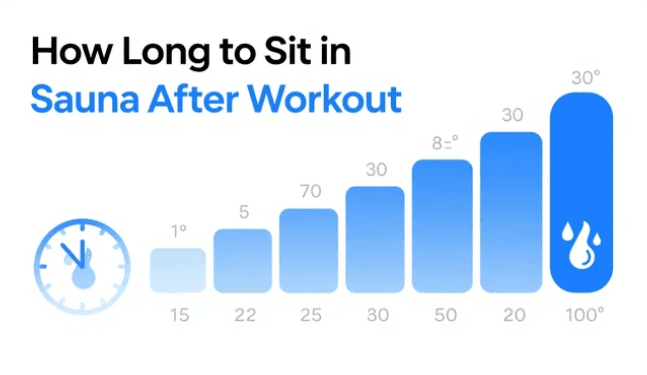How Long to Sit in Sauna After Workout? Benefits, Risks, and Best Practices
Introduction
Many gym-goers love the idea of finishing a workout with a relaxing sauna session. The warm environment not only feels soothing but is often praised for aiding recovery, flushing toxins, and promoting relaxation.
However, one of the most common questions is: how long should you sit in a sauna after a workout? Staying too short may reduce the benefits, while staying too long can increase health risks.
This article will explore the optimal sauna duration, the benefits, safety concerns, and tips for maximizing your post-workout sauna routine.
Why People Use Sauna After Workouts
Saunas have been used for centuries as a form of relaxation and healing. After intense physical activity, your body undergoes stress and muscle breakdown.
A sauna provides a calm, heated environment that can help muscles relax and increase circulation. Many athletes also report improved mental clarity and better sleep after regular sauna use.
The combination of physical recovery and psychological comfort is why many people incorporate it into their fitness routines.
How Long Should You Stay in the Sauna?
The ideal sauna duration depends on your experience level, health condition, and the sauna type.
For most people, the recommended time is between 10 to 20 minutes. Beginners should start at the lower end, while experienced sauna users can gradually increase to 15–20 minutes.
It is generally not recommended to stay beyond 30 minutes, as excessive heat exposure can lead to dehydration, dizziness, or even fainting.
It’s important to listen to your body. If you start feeling lightheaded or overly fatigued, it is better to exit the sauna early rather than push your limits.
Factors That Affect Sauna Duration
Several variables influence how long you should stay in a sauna after your workout:
- Sauna type: Traditional saunas reach higher temperatures than infrared saunas, which means shorter durations are safer in traditional setups.
- Hydration level: If you are dehydrated from exercise, limit sauna time to avoid excessive fluid loss.
- Fitness level: Experienced athletes may tolerate longer sessions due to better heat adaptation.
- Overall health: People with heart conditions, respiratory issues, or low blood pressure should consult a doctor before using saunas.
Benefits of Sauna After Workout
When done correctly, post-workout sauna sessions can offer numerous benefits:
- Muscle recovery: Heat increases blood circulation, helping transport oxygen and nutrients to muscles faster.
- Detoxification: Sweating helps eliminate toxins and heavy metals from the body.
- Stress reduction: Heat exposure stimulates the release of endorphins, improving mood and lowering stress hormones.
- Better sleep: Many sauna users report improved sleep quality after evening sessions.
- Improved cardiovascular health: Regular sauna use can mimic some of the effects of moderate exercise on the heart and blood vessels.
Risks of Staying Too Long
Although saunas have many health benefits, overexposure can be harmful. Risks include:
- Dehydration: Prolonged sweating leads to significant fluid loss.
- Overheating: Staying too long can cause dizziness, nausea, or heat exhaustion.
- Heart strain: For individuals with pre-existing heart conditions, excessive sauna use may put extra pressure on the cardiovascular system.
To avoid these issues, always hydrate before and after your sauna session, and never exceed recommended times.
Best Practices for Sauna Use After Exercise
To maximize benefits and minimize risks, follow these expert tips:
- Wait at least 5–10 minutes after finishing your workout before entering the sauna. This allows your heart rate to stabilize.
- Stay hydrated by drinking water or electrolyte beverages before and after.
- Start with shorter sessions (5–10 minutes) if you are new to sauna use.
- Listen to your body and exit immediately if you feel uncomfortable.
- Avoid alcohol or stimulants before using the sauna, as they increase dehydration risk.
Infrared vs. Traditional Sauna Duration
Traditional saunas operate at higher temperatures (160–200°F), making shorter sessions safer. Infrared saunas run at lower temperatures (110–140°F) and penetrate deeper into tissues, allowing for slightly longer stays.
For traditional saunas, stick to 10–20 minutes, while for infrared saunas, 20–30 minutes may be appropriate depending on tolerance.
Who Should Avoid Saunas?
While saunas are generally safe for healthy adults, certain groups should avoid them or consult a doctor before use:
- People with cardiovascular conditions such as arrhythmia or recent heart attacks.
- Pregnant women, unless cleared by a healthcare professional.
- Individuals with uncontrolled high blood pressure.
- Those prone to fainting or heat intolerance.
Sauna After Workout vs. Other Recovery Methods
A sauna is just one recovery option. Some people prefer ice baths, compression therapy, or gentle stretching.
Each has unique benefits: ice baths reduce inflammation, while saunas promote circulation.
Many athletes combine multiple recovery methods for the best results. Your choice should depend on your goals, tolerance, and health status.
Conclusion
So, how long should you sit in a sauna after a workout? For most people, 10 to 20 minutes is ideal. Beginners should start on the shorter side, while seasoned users can extend their sessions slightly.
The key is balance: enough time to gain the recovery benefits without risking dehydration or overheating. By using the sauna wisely, you can enhance recovery, improve relaxation, and enjoy an overall boost to your fitness routine.







BodyWave: Invest in Your Well-being!

